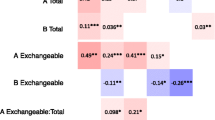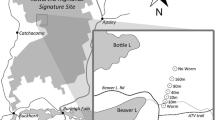Abstract
A greenhouse mesocosm experiment, representing earthworm-free North American Acer-dominated forest floor and soil conditions, was used to examine the individual and combined effects of initial invasion by three European earthworm species (Dendrobaena octaedra, Lumbricus rubellus and Lumbricus terrestris) on the forest floor and upper soil horizons, N and P availability, and the mortality and biomass of four native understory plant species (Acer saccharum, Aquilegia canadensis, Aralia racemosa, and Carex pensylvanica). All the three earthworm species combined caused larger impacts on most variables measured than any single earthworm species. These included loss of O horizon mass, decreased thickness of the O horizon and increased thickness of the A horizon, and higher availability of N and P. The latter finding differs from field reports where nutrients were less available after invasion, and probably represents an initial transient increase in nutrient supply as earthworms consume and incorporate the O horizon into the A horizon. Earthworms also increased mortality of plants and decreased total mesocosm plant biomass, but here the impact of all the three earthworm species was no greater than that of L. terrestris and/or L. rubellus alone. This study corroborates field studies that European earthworm invasions alter North American forest ecosystem processes by initiating a cascade of impacts on plant community composition and soil properties.





Similar content being viewed by others
References
Alban DH, Berry EC (1994) Effects of earthworm invasion on morphology, carbon and nitrogen of a forest soil. Appl Soil Ecol 1:243–249
Alphei J, Bonkowski M, Scheu S (1996) Protozoa, Nematoda and Lumbricidae in the rhizosphere of Hordelymus europaeus (Poaceae): faunal interactions, response of microorganisms and effects on plant growth. Oecologia 106:111–126
Augustine DJ (1997) Grazing patterns and impacts of white-tailed deer in a fragmented forest ecosystem. MS thesis, University of Minnesota, St Paul
Augustine DJ, Frelich LE, Jordan PA (1998) Evidence for two alternate stable states in an ungulate grazing system. Ecol Appl 8:1260–1269
Binkley D (1984) Ion exchange resin bags: factors affecting estimates of nitrogen availability. Soil Sci Soc Am J 48:1181–1184
Blair JM, Parmelee RW, Lavelle P (1995) Influences of earthworms on biogeochemistry. In: Hendrix PF (ed) Earthworm ecology and biogeography in North America. Lewis, Boca Raton, pp 127–158
Blouin M, Barot S, Lavelle P (2006) Earthworms (Millsonia anomala, Megascolecidae) do not increase rice growth through enhanced nitrogen mineralization. Soil Biol Biochem 38:2063–2068
Bohlen PJ, Groffman PM, Fahey TJ, Fisk MC, Suarez ER, Pelletier DM, Fahey TJ (2004a) Ecosystem consequences of exotic earthworm invasion of north temperate forests. Ecosystems 7(1):1–12
Bohlen PJ, Pelletier DM, Groffman PM, Fahey TJ, Fisk MC (2004b) Influence of earthworm invasion on redistribution and retention of soil carbon and nitrogen in north temperate forests. Ecosystems 7(1):13–27
Bouché MB (1977) Strategies lombriciennes. Ecol Bull 25:122–132
Brown GC, Edwards CA, Brussaard L (2004) How earthworms affect plant growth: burrowing into the mechanisms. In: Edwards CA (ed) Earthworm ecology, 2nd edn. CRC, Boca Raton, pp 13–49
Brundrett MC, Kendrick B (1988) The mycorrhizal status, root anatomy, and phenology of plants in a sugar maple forest. Can J Bot 66:1153–1173
Callaham M Jr, Hendrix PF (1998) Impact of earthworms (Diplocardia: Megascolecidae) on cycling and uptake of nitrogen in coastal plain forest soils from northwest Florida, USA. Appl Soil Ecol 9:233–239
Cothrel SR, Vimmerstedt JP, Kost DA (1997) In situ recycling of urban deciduous litter. Soil Biol Biochem 29:295–298
Dymond P, Scheu S, Parkinson D (1997) Density and distribution of Dendrobaena octaedra (Lumbricidae) in aspen and pine forests in the Canadian Rocky mountains (Alberta). Soil Biol Biochem 29:265–273
Edwards CA, Bohlen PJ, Linden DR, Subler S (1995) Earthworms in agroecosystems. In: Hendrix PF (ed) Earthworm ecology and biogeography in North America. Lewis, Boca Raton, pp 185–214
Fisk MC, Fahey TJ, Groffman PM, Bohlen PJ (2004) Earthworm invasion, fine root distribution and soil respiration in hardwood forests. Ecosystems 7:55–62
Frelich LE, Hale CM, Scheu S, Holdsworth AR, Heneghan L, Bohlen PJ, Reich PB (2006) Earthworm invasion into previously earthworm-free temperate and boreal forests. Biol Invasions 8:1235–1245
Gundale MJ (2002) The influence of exotic earthworms on soil organic horizon and the rare fern Botrychium mormo. Cons Biol 16:1555–1573
Hale CM, Pastor J, Rusterholz KA (1999) Comparison of structural and compositional characteristics in old-growth versus mature hardwood forests of Minnesota, USA. Can J For Res 29:1479–1489
Hale CM, Frelich LE, Reich PB (2004) Allometric equations for estimation of ash-free dry mass from length measurements for selected European earthworm species (Lumbricidae) in the western Great Lakes region. Am Mid Nat 151(1):179–185
Hale CM, Frelich LE, Reich PB (2005a) Exotic European earthworm invasion dynamics in northern hardwood forests of Minnesota, USA. Ecol Appl 15(3):848–860
Hale CM, Frelich LE, Reich PB (2005b) Effects of European earthworm invasion on soil characteristics in northern hardwood forests of Minnesota, USA. Ecosystems 8:911–927
Hale CM, Frelich LE, Reich PB (2006) Changes in cold-temperate hardwood forest understory plant communities in response to invasion by European earthworms. Ecology 87:1637–1649
Hendriksen NB (1990) Leaf litter selection by detrivore and geophagous earthworms. Biol Fertil Soils 10:17–21
Hendrix PF, Callaham MA, Lachnicht SL, Blair JM, James SW, Zou X (1999) Stable isotopic studies of resource utilization by nearctic earthworms (Diplocardia, Oligochaeta) in subtropical savanna and forest ecosystems. Pedobiologia 43:818–823
Holdsworth AR (2006) Earthworm invasion: patterns, ecological effects, and implications for conservation in northern hardwood forests. PhD thesis, University of Minnesota, St Paul
Holdsworth AR, Frelich LE, Reich PB (2007) Effects of earthworm invasion on plant species richness in northern hardwood forests. Cons Biol 21:997–1008
James SW, Seastedt TR (1986) Nitrogen mineralization by native and introduced earthworms: effects on big bluestem growth. Ecology 67:1094–1097
Knollenberg WG, Merritt RW, Lawson DL (1985) Consumption of leaf litter by Lumbricus terrestris (Oligochaeta) on a Michigan woodland floodplain. Am Midl Nat 113:1–6
Kourtev PS, Huang WZ, Ehrenfeld JG (1999) Differences in earthworm densities and nitrogen dynamics in soils under exotic and native plant species. Biol Invasions 1:235
Lavelle P (1997) Faunal activities and soil processes: adaptive strategies that determine ecosystem function. In: Begon M, Fitter AH (eds) Advances in ecological research. Academic, San Diego, pp 93–122
Lavelle P, Melendez G, Pashanasi B, Szott L, Schaefer R (1992) Nitrogen mineralization and reorganization in casts of the geophagous tropical earthworm Pontoscolex corethurus (Glossoscolecidae). Biol Fertil Soils 14:49–53
Lavelle P, Pashanasi B, Charpentier F, Gilot C, Rossi JP, Derouard L, Andre J, Ponge JF, Bernier N (1998) Large-scale effects of earthworms on soil organic matter and nutrient dynamics. In: Edwards CA (ed) Earthworm ecology. St Lucie Press, Boca Raton, pp 103–122
Lee KE (1985) Earthworms: their ecology and relationships with soils and land use. Academic, New York
McLean MA, Parkinson D (2000) Field evidence of the effects of the epigeic earthworm Dendrobaena octaedra on the microfungal community in pine forest floor. Soil Biol Biochem 32:351–360
Nielsen GA, Hole FD (1963) A study of the natural processes of incorporation of organic matter into soil in the University of Wisconsin Arboretum. Wis Acad Sci Arts Lett 52:213–227
Nielsen GA, Hole FD (1964) Earthworms and the development of coprogenous A1 horizons in forest soils of Wisconsin. Soil Sci Soc Am Proc 28:426–430
Pashanasi B, Melendez G, Szott L, Lavelle P (1992) Effect of inoculation with the endogeic earthworm Pontoscolex corethrurus (glossoscolecidae) on N availability, soil microbial biomass and the growth of three tropical fruit tree seedlings in a pot experiment. Soil Biol Biochem 24:1655–1659
Piearce TG (1978) Gut contents of some lumbricid earthworms. Pedobiologia 18:153–157
Pitkänen J, Nuutinen V (1997) Distribution and abundance of burrows formed by Lumbricus terrestris and Aporrectodea caliginosa in the soil profile. Soil Biol Biochem 29:463–467
Reich PB, Oleksyn J, Modrzynski J, Mrozinski P, Hobbie SE, Eissenstat DM, Chorover J, Chadwick OA, Hale CM, Tjoelker MG (2005) Linking litter calcium, earthworms and soil properties: a common garden test with 14 temperate tree species. Ecol Lett 8:811–818
Rozen A (1988) The annual cycle in populations of earthworms (Lumbricidae, Oligochaeta) in three types of oak-hornbeam of the Niepolomicka Forest. II. Dynamics of population numbers, biomass and age structure. Pedobiologia 31:169–178
SAS Institute (2001) JMP, version 4.0.5. SAS Institute. 100 SAS Campus Drive, Cary
Scheu S (2003) Effects of earthworms on plant growth: patterns and perspectives. Pedobiologia 47:846–856
Scheu S, Parkinson D (1994) Effects of earthworms on nutrient dynamics, carbon turnover and microorganisms in soils from cool temperate forests of the Canadian Rocky Mountains—laboratory studies. Appl Soil Ecol 1:113–125
Shaw C, Pawluk S (1986) The development of soil structure by Octolasion tyrtaeum, Aporrectodea turgida and Lumbricus terrestris in parent materials belonging to different textural classes. Pedobiologia 29:327–339
Suárez ER, Pelletier DM, Fahey TJ, Groffman PM, Bohlen PJ, Fisk MC (2004) Effects of exotic earthworms on soil phosphorus cycling in two broadleaf temperate forests. Ecosystems 7:28–44
Tiunov AV, Hale CM, Holdsworth AR, Perel TS (2006) Invasion patterns of Lumbricidae into the previously earthworm-free areas of north-eastern Europe and the western Great Lakes region of North America. Biol Invasions 8:1223–1234
USDA (1997) Soil survey of Cass County, Minnesota. National cooperative soil survey, US Department of Agriculture and Minnesota Natural Resources Conservation Service
Acknowledgements
This research was supported by a grant from the National Science Foundation (DEB-0075236), The Wilderness Research Foundation, the Lydia P. Anderson Fellowship, the Wood-Rill Fellowship from the University of Minnesota Center for Hardwood Ecology, and a University of Minnesota Doctoral Dissertation Fellowship. The late D. Dennis Linden contributed substantially to this project. Experiments performed for this study comply with US law.
Author information
Authors and Affiliations
Corresponding author
Additional information
Communicated by M. Bustamante.
Rights and permissions
About this article
Cite this article
Hale, C.M., Frelich, L.E., Reich, P.B. et al. Exotic earthworm effects on hardwood forest floor, nutrient availability and native plants: a mesocosm study. Oecologia 155, 509–518 (2008). https://doi.org/10.1007/s00442-007-0925-6
Received:
Revised:
Accepted:
Published:
Issue Date:
DOI: https://doi.org/10.1007/s00442-007-0925-6




